Contract Formation Analysis
VerifiedAdded on 2020/03/13
|9
|2035
|39
AI Summary
This assignment analyzes a case study involving three parties negotiating a contract for goods. The analysis focuses on identifying the various stages of contract formation – invitation to treat, offer, acceptance – and explores how clarity in contractual terms impacts contract validity. It highlights the legal implications and the specific date when a legally binding contract was formed.
Contribute Materials
Your contribution can guide someone’s learning journey. Share your
documents today.

Secure Best Marks with AI Grader
Need help grading? Try our AI Grader for instant feedback on your assignments.
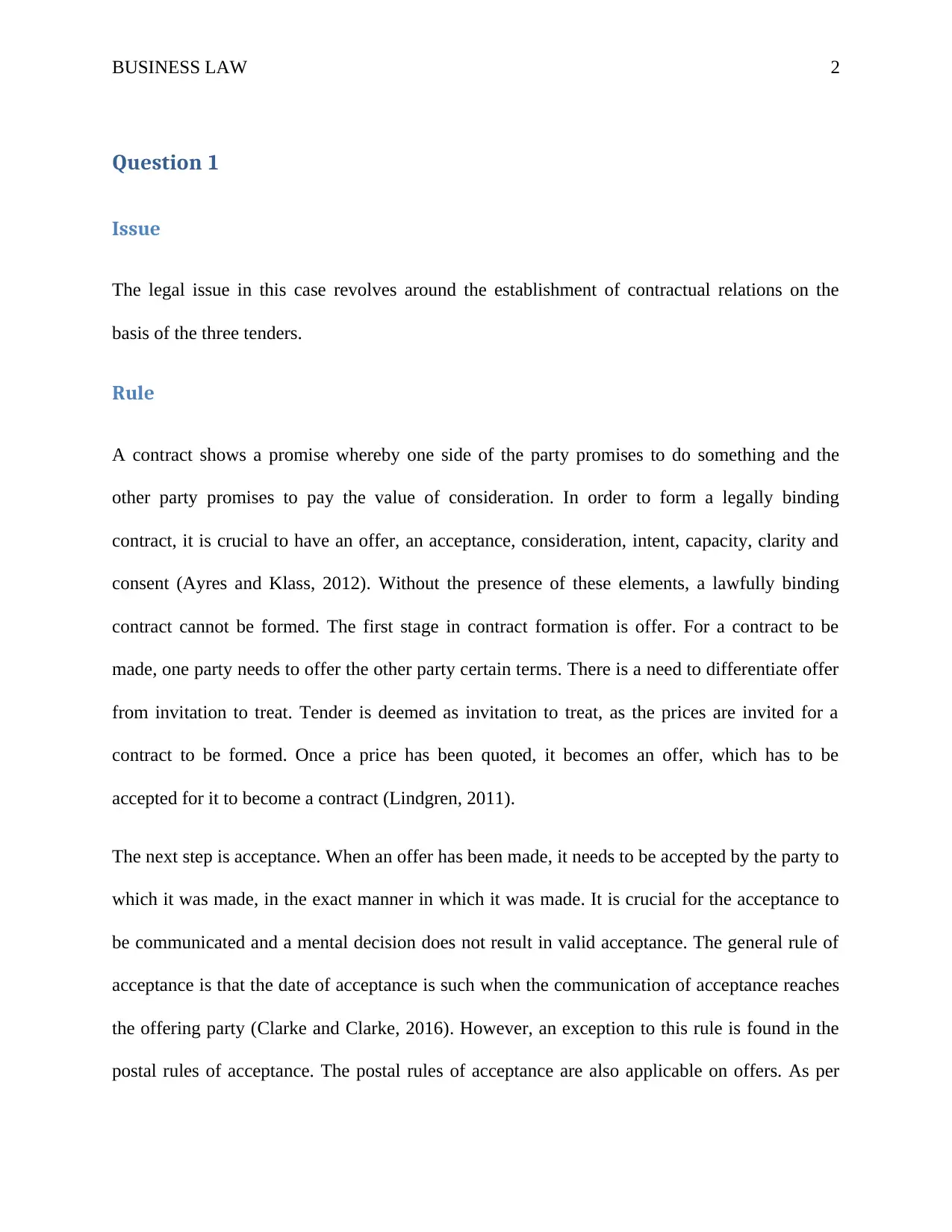
BUSINESS LAW 2
Question 1
Issue
The legal issue in this case revolves around the establishment of contractual relations on the
basis of the three tenders.
Rule
A contract shows a promise whereby one side of the party promises to do something and the
other party promises to pay the value of consideration. In order to form a legally binding
contract, it is crucial to have an offer, an acceptance, consideration, intent, capacity, clarity and
consent (Ayres and Klass, 2012). Without the presence of these elements, a lawfully binding
contract cannot be formed. The first stage in contract formation is offer. For a contract to be
made, one party needs to offer the other party certain terms. There is a need to differentiate offer
from invitation to treat. Tender is deemed as invitation to treat, as the prices are invited for a
contract to be formed. Once a price has been quoted, it becomes an offer, which has to be
accepted for it to become a contract (Lindgren, 2011).
The next step is acceptance. When an offer has been made, it needs to be accepted by the party to
which it was made, in the exact manner in which it was made. It is crucial for the acceptance to
be communicated and a mental decision does not result in valid acceptance. The general rule of
acceptance is that the date of acceptance is such when the communication of acceptance reaches
the offering party (Clarke and Clarke, 2016). However, an exception to this rule is found in the
postal rules of acceptance. The postal rules of acceptance are also applicable on offers. As per
Question 1
Issue
The legal issue in this case revolves around the establishment of contractual relations on the
basis of the three tenders.
Rule
A contract shows a promise whereby one side of the party promises to do something and the
other party promises to pay the value of consideration. In order to form a legally binding
contract, it is crucial to have an offer, an acceptance, consideration, intent, capacity, clarity and
consent (Ayres and Klass, 2012). Without the presence of these elements, a lawfully binding
contract cannot be formed. The first stage in contract formation is offer. For a contract to be
made, one party needs to offer the other party certain terms. There is a need to differentiate offer
from invitation to treat. Tender is deemed as invitation to treat, as the prices are invited for a
contract to be formed. Once a price has been quoted, it becomes an offer, which has to be
accepted for it to become a contract (Lindgren, 2011).
The next step is acceptance. When an offer has been made, it needs to be accepted by the party to
which it was made, in the exact manner in which it was made. It is crucial for the acceptance to
be communicated and a mental decision does not result in valid acceptance. The general rule of
acceptance is that the date of acceptance is such when the communication of acceptance reaches
the offering party (Clarke and Clarke, 2016). However, an exception to this rule is found in the
postal rules of acceptance. The postal rules of acceptance are also applicable on offers. As per
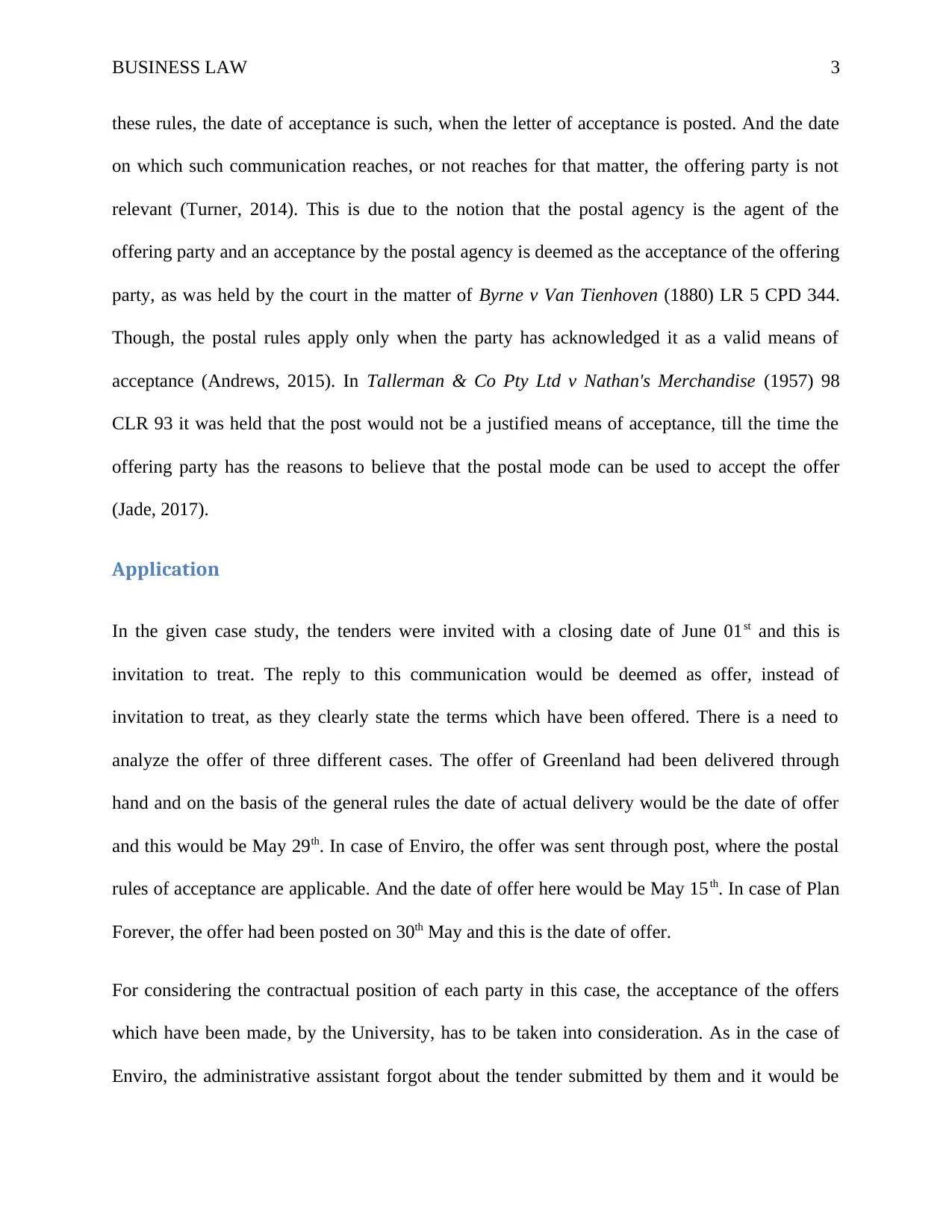
BUSINESS LAW 3
these rules, the date of acceptance is such, when the letter of acceptance is posted. And the date
on which such communication reaches, or not reaches for that matter, the offering party is not
relevant (Turner, 2014). This is due to the notion that the postal agency is the agent of the
offering party and an acceptance by the postal agency is deemed as the acceptance of the offering
party, as was held by the court in the matter of Byrne v Van Tienhoven (1880) LR 5 CPD 344.
Though, the postal rules apply only when the party has acknowledged it as a valid means of
acceptance (Andrews, 2015). In Tallerman & Co Pty Ltd v Nathan's Merchandise (1957) 98
CLR 93 it was held that the post would not be a justified means of acceptance, till the time the
offering party has the reasons to believe that the postal mode can be used to accept the offer
(Jade, 2017).
Application
In the given case study, the tenders were invited with a closing date of June 01st and this is
invitation to treat. The reply to this communication would be deemed as offer, instead of
invitation to treat, as they clearly state the terms which have been offered. There is a need to
analyze the offer of three different cases. The offer of Greenland had been delivered through
hand and on the basis of the general rules the date of actual delivery would be the date of offer
and this would be May 29th. In case of Enviro, the offer was sent through post, where the postal
rules of acceptance are applicable. And the date of offer here would be May 15th. In case of Plan
Forever, the offer had been posted on 30th May and this is the date of offer.
For considering the contractual position of each party in this case, the acceptance of the offers
which have been made, by the University, has to be taken into consideration. As in the case of
Enviro, the administrative assistant forgot about the tender submitted by them and it would be
these rules, the date of acceptance is such, when the letter of acceptance is posted. And the date
on which such communication reaches, or not reaches for that matter, the offering party is not
relevant (Turner, 2014). This is due to the notion that the postal agency is the agent of the
offering party and an acceptance by the postal agency is deemed as the acceptance of the offering
party, as was held by the court in the matter of Byrne v Van Tienhoven (1880) LR 5 CPD 344.
Though, the postal rules apply only when the party has acknowledged it as a valid means of
acceptance (Andrews, 2015). In Tallerman & Co Pty Ltd v Nathan's Merchandise (1957) 98
CLR 93 it was held that the post would not be a justified means of acceptance, till the time the
offering party has the reasons to believe that the postal mode can be used to accept the offer
(Jade, 2017).
Application
In the given case study, the tenders were invited with a closing date of June 01st and this is
invitation to treat. The reply to this communication would be deemed as offer, instead of
invitation to treat, as they clearly state the terms which have been offered. There is a need to
analyze the offer of three different cases. The offer of Greenland had been delivered through
hand and on the basis of the general rules the date of actual delivery would be the date of offer
and this would be May 29th. In case of Enviro, the offer was sent through post, where the postal
rules of acceptance are applicable. And the date of offer here would be May 15th. In case of Plan
Forever, the offer had been posted on 30th May and this is the date of offer.
For considering the contractual position of each party in this case, the acceptance of the offers
which have been made, by the University, has to be taken into consideration. As in the case of
Enviro, the administrative assistant forgot about the tender submitted by them and it would be
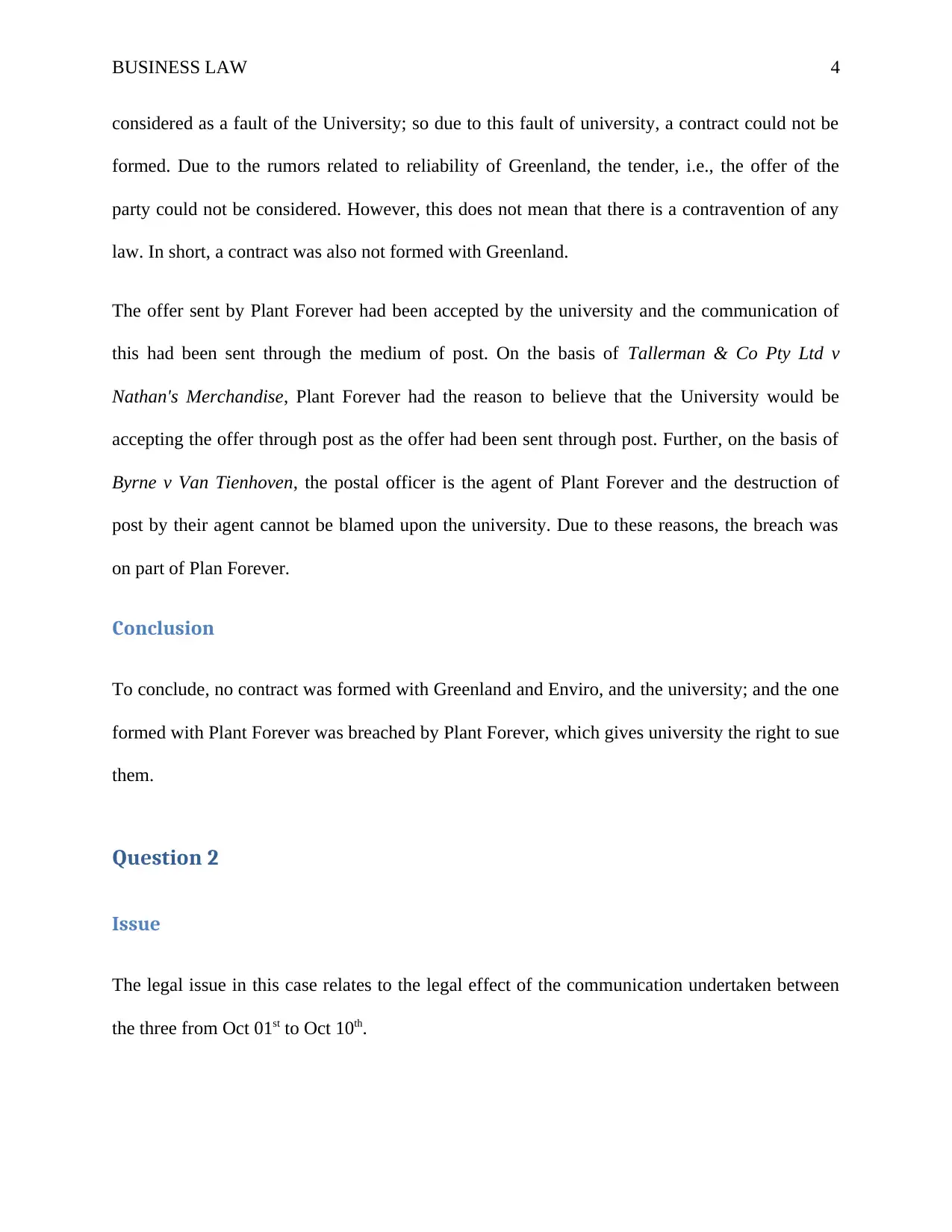
BUSINESS LAW 4
considered as a fault of the University; so due to this fault of university, a contract could not be
formed. Due to the rumors related to reliability of Greenland, the tender, i.e., the offer of the
party could not be considered. However, this does not mean that there is a contravention of any
law. In short, a contract was also not formed with Greenland.
The offer sent by Plant Forever had been accepted by the university and the communication of
this had been sent through the medium of post. On the basis of Tallerman & Co Pty Ltd v
Nathan's Merchandise, Plant Forever had the reason to believe that the University would be
accepting the offer through post as the offer had been sent through post. Further, on the basis of
Byrne v Van Tienhoven, the postal officer is the agent of Plant Forever and the destruction of
post by their agent cannot be blamed upon the university. Due to these reasons, the breach was
on part of Plan Forever.
Conclusion
To conclude, no contract was formed with Greenland and Enviro, and the university; and the one
formed with Plant Forever was breached by Plant Forever, which gives university the right to sue
them.
Question 2
Issue
The legal issue in this case relates to the legal effect of the communication undertaken between
the three from Oct 01st to Oct 10th.
considered as a fault of the University; so due to this fault of university, a contract could not be
formed. Due to the rumors related to reliability of Greenland, the tender, i.e., the offer of the
party could not be considered. However, this does not mean that there is a contravention of any
law. In short, a contract was also not formed with Greenland.
The offer sent by Plant Forever had been accepted by the university and the communication of
this had been sent through the medium of post. On the basis of Tallerman & Co Pty Ltd v
Nathan's Merchandise, Plant Forever had the reason to believe that the University would be
accepting the offer through post as the offer had been sent through post. Further, on the basis of
Byrne v Van Tienhoven, the postal officer is the agent of Plant Forever and the destruction of
post by their agent cannot be blamed upon the university. Due to these reasons, the breach was
on part of Plan Forever.
Conclusion
To conclude, no contract was formed with Greenland and Enviro, and the university; and the one
formed with Plant Forever was breached by Plant Forever, which gives university the right to sue
them.
Question 2
Issue
The legal issue in this case relates to the legal effect of the communication undertaken between
the three from Oct 01st to Oct 10th.
Secure Best Marks with AI Grader
Need help grading? Try our AI Grader for instant feedback on your assignments.
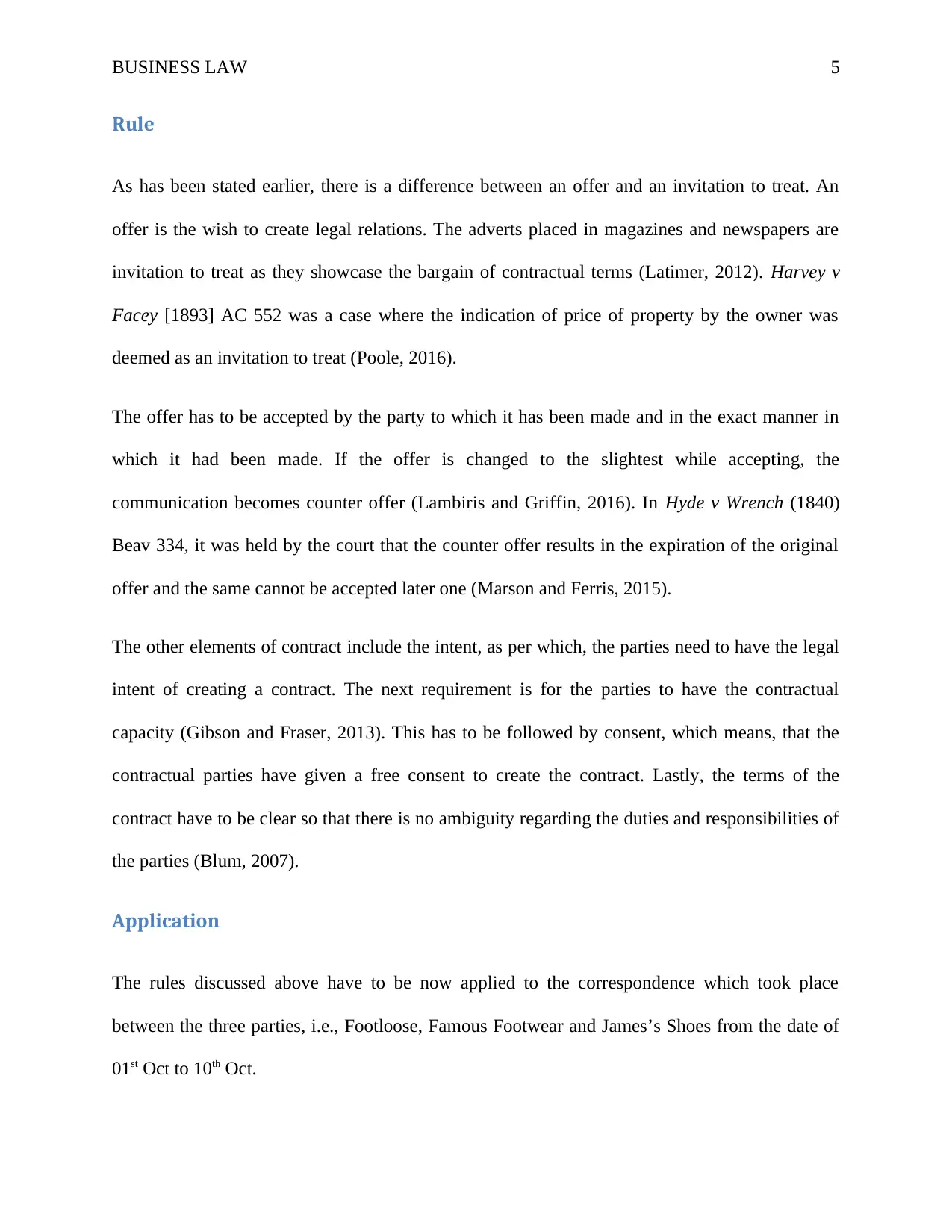
BUSINESS LAW 5
Rule
As has been stated earlier, there is a difference between an offer and an invitation to treat. An
offer is the wish to create legal relations. The adverts placed in magazines and newspapers are
invitation to treat as they showcase the bargain of contractual terms (Latimer, 2012). Harvey v
Facey [1893] AC 552 was a case where the indication of price of property by the owner was
deemed as an invitation to treat (Poole, 2016).
The offer has to be accepted by the party to which it has been made and in the exact manner in
which it had been made. If the offer is changed to the slightest while accepting, the
communication becomes counter offer (Lambiris and Griffin, 2016). In Hyde v Wrench (1840)
Beav 334, it was held by the court that the counter offer results in the expiration of the original
offer and the same cannot be accepted later one (Marson and Ferris, 2015).
The other elements of contract include the intent, as per which, the parties need to have the legal
intent of creating a contract. The next requirement is for the parties to have the contractual
capacity (Gibson and Fraser, 2013). This has to be followed by consent, which means, that the
contractual parties have given a free consent to create the contract. Lastly, the terms of the
contract have to be clear so that there is no ambiguity regarding the duties and responsibilities of
the parties (Blum, 2007).
Application
The rules discussed above have to be now applied to the correspondence which took place
between the three parties, i.e., Footloose, Famous Footwear and James’s Shoes from the date of
01st Oct to 10th Oct.
Rule
As has been stated earlier, there is a difference between an offer and an invitation to treat. An
offer is the wish to create legal relations. The adverts placed in magazines and newspapers are
invitation to treat as they showcase the bargain of contractual terms (Latimer, 2012). Harvey v
Facey [1893] AC 552 was a case where the indication of price of property by the owner was
deemed as an invitation to treat (Poole, 2016).
The offer has to be accepted by the party to which it has been made and in the exact manner in
which it had been made. If the offer is changed to the slightest while accepting, the
communication becomes counter offer (Lambiris and Griffin, 2016). In Hyde v Wrench (1840)
Beav 334, it was held by the court that the counter offer results in the expiration of the original
offer and the same cannot be accepted later one (Marson and Ferris, 2015).
The other elements of contract include the intent, as per which, the parties need to have the legal
intent of creating a contract. The next requirement is for the parties to have the contractual
capacity (Gibson and Fraser, 2013). This has to be followed by consent, which means, that the
contractual parties have given a free consent to create the contract. Lastly, the terms of the
contract have to be clear so that there is no ambiguity regarding the duties and responsibilities of
the parties (Blum, 2007).
Application
The rules discussed above have to be now applied to the correspondence which took place
between the three parties, i.e., Footloose, Famous Footwear and James’s Shoes from the date of
01st Oct to 10th Oct.
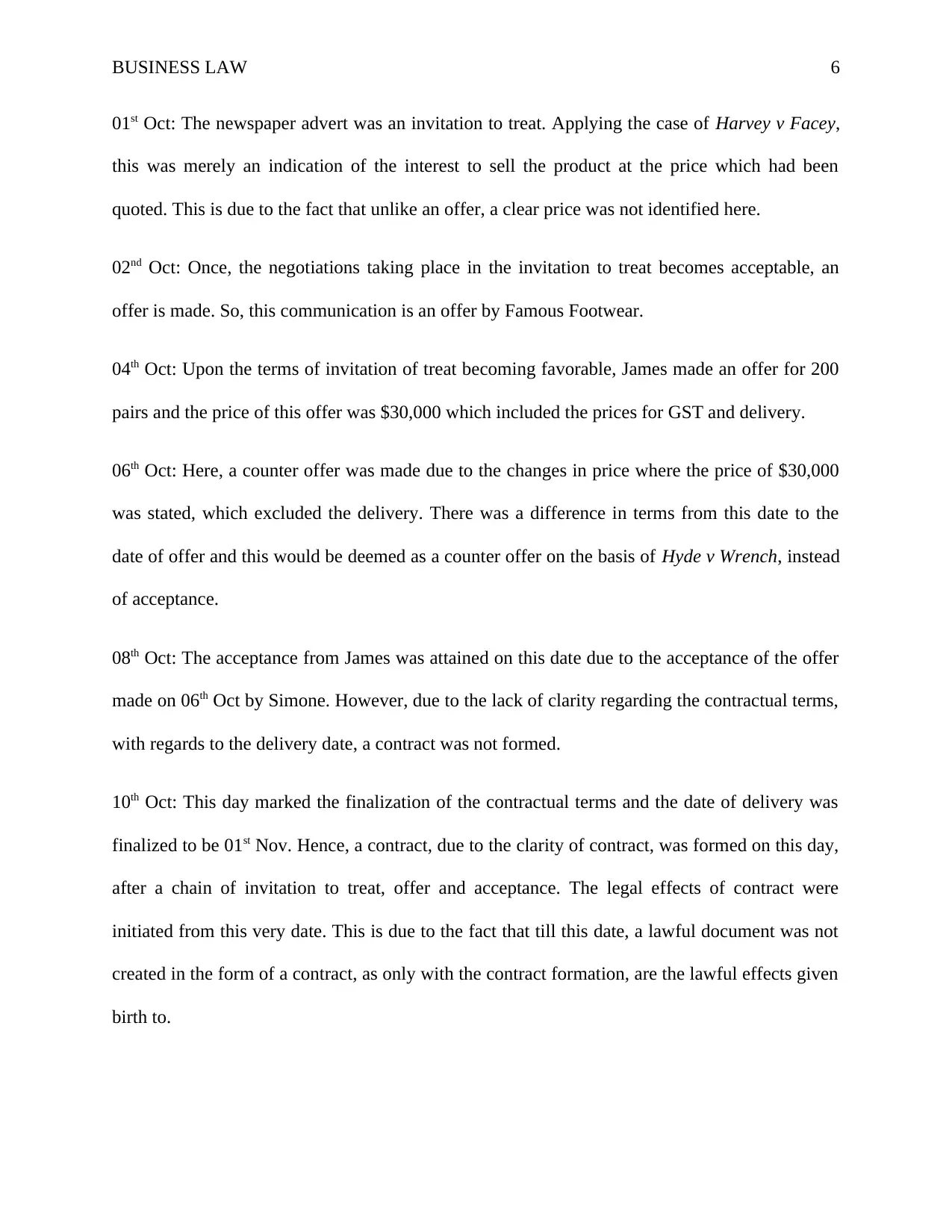
BUSINESS LAW 6
01st Oct: The newspaper advert was an invitation to treat. Applying the case of Harvey v Facey,
this was merely an indication of the interest to sell the product at the price which had been
quoted. This is due to the fact that unlike an offer, a clear price was not identified here.
02nd Oct: Once, the negotiations taking place in the invitation to treat becomes acceptable, an
offer is made. So, this communication is an offer by Famous Footwear.
04th Oct: Upon the terms of invitation of treat becoming favorable, James made an offer for 200
pairs and the price of this offer was $30,000 which included the prices for GST and delivery.
06th Oct: Here, a counter offer was made due to the changes in price where the price of $30,000
was stated, which excluded the delivery. There was a difference in terms from this date to the
date of offer and this would be deemed as a counter offer on the basis of Hyde v Wrench, instead
of acceptance.
08th Oct: The acceptance from James was attained on this date due to the acceptance of the offer
made on 06th Oct by Simone. However, due to the lack of clarity regarding the contractual terms,
with regards to the delivery date, a contract was not formed.
10th Oct: This day marked the finalization of the contractual terms and the date of delivery was
finalized to be 01st Nov. Hence, a contract, due to the clarity of contract, was formed on this day,
after a chain of invitation to treat, offer and acceptance. The legal effects of contract were
initiated from this very date. This is due to the fact that till this date, a lawful document was not
created in the form of a contract, as only with the contract formation, are the lawful effects given
birth to.
01st Oct: The newspaper advert was an invitation to treat. Applying the case of Harvey v Facey,
this was merely an indication of the interest to sell the product at the price which had been
quoted. This is due to the fact that unlike an offer, a clear price was not identified here.
02nd Oct: Once, the negotiations taking place in the invitation to treat becomes acceptable, an
offer is made. So, this communication is an offer by Famous Footwear.
04th Oct: Upon the terms of invitation of treat becoming favorable, James made an offer for 200
pairs and the price of this offer was $30,000 which included the prices for GST and delivery.
06th Oct: Here, a counter offer was made due to the changes in price where the price of $30,000
was stated, which excluded the delivery. There was a difference in terms from this date to the
date of offer and this would be deemed as a counter offer on the basis of Hyde v Wrench, instead
of acceptance.
08th Oct: The acceptance from James was attained on this date due to the acceptance of the offer
made on 06th Oct by Simone. However, due to the lack of clarity regarding the contractual terms,
with regards to the delivery date, a contract was not formed.
10th Oct: This day marked the finalization of the contractual terms and the date of delivery was
finalized to be 01st Nov. Hence, a contract, due to the clarity of contract, was formed on this day,
after a chain of invitation to treat, offer and acceptance. The legal effects of contract were
initiated from this very date. This is due to the fact that till this date, a lawful document was not
created in the form of a contract, as only with the contract formation, are the lawful effects given
birth to.
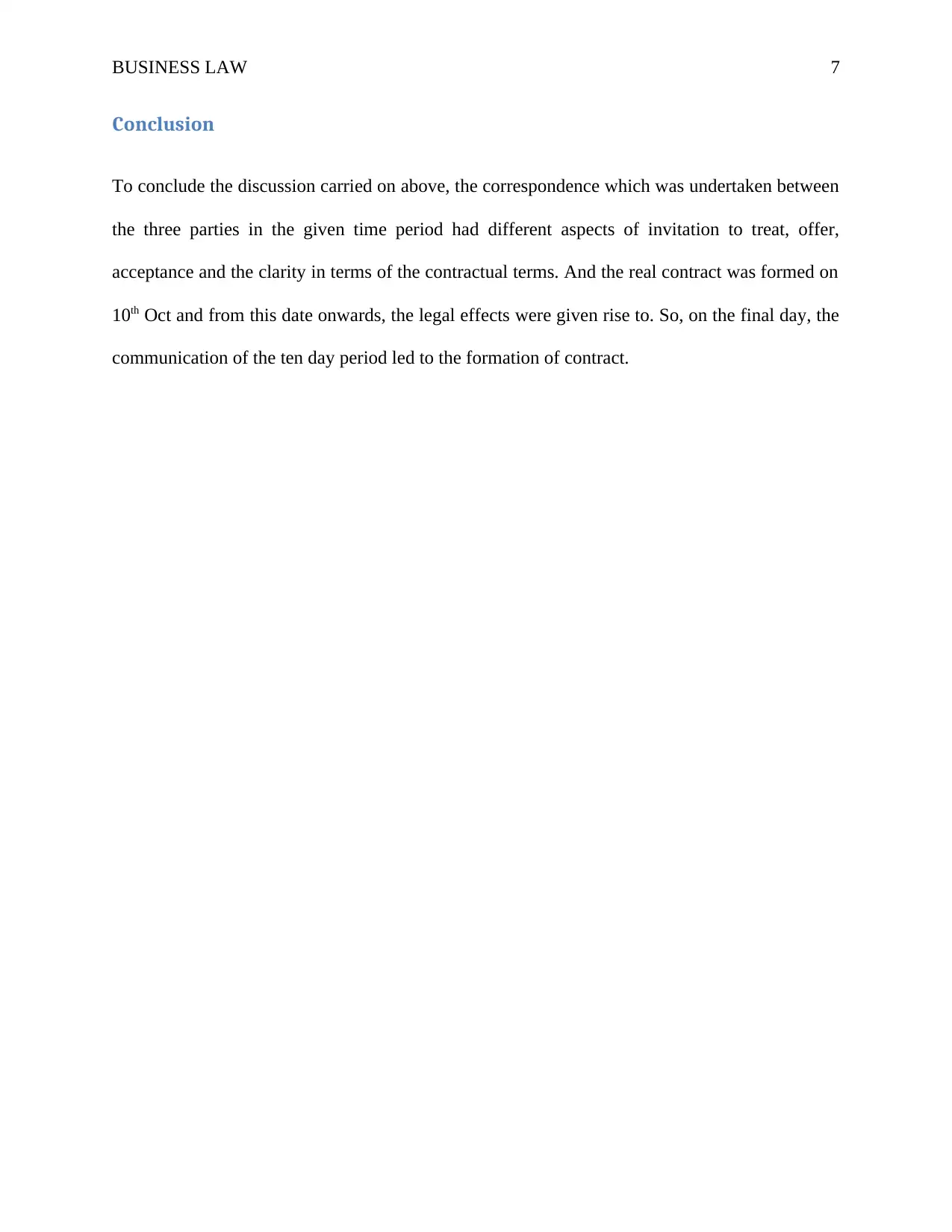
BUSINESS LAW 7
Conclusion
To conclude the discussion carried on above, the correspondence which was undertaken between
the three parties in the given time period had different aspects of invitation to treat, offer,
acceptance and the clarity in terms of the contractual terms. And the real contract was formed on
10th Oct and from this date onwards, the legal effects were given rise to. So, on the final day, the
communication of the ten day period led to the formation of contract.
Conclusion
To conclude the discussion carried on above, the correspondence which was undertaken between
the three parties in the given time period had different aspects of invitation to treat, offer,
acceptance and the clarity in terms of the contractual terms. And the real contract was formed on
10th Oct and from this date onwards, the legal effects were given rise to. So, on the final day, the
communication of the ten day period led to the formation of contract.
Paraphrase This Document
Need a fresh take? Get an instant paraphrase of this document with our AI Paraphraser
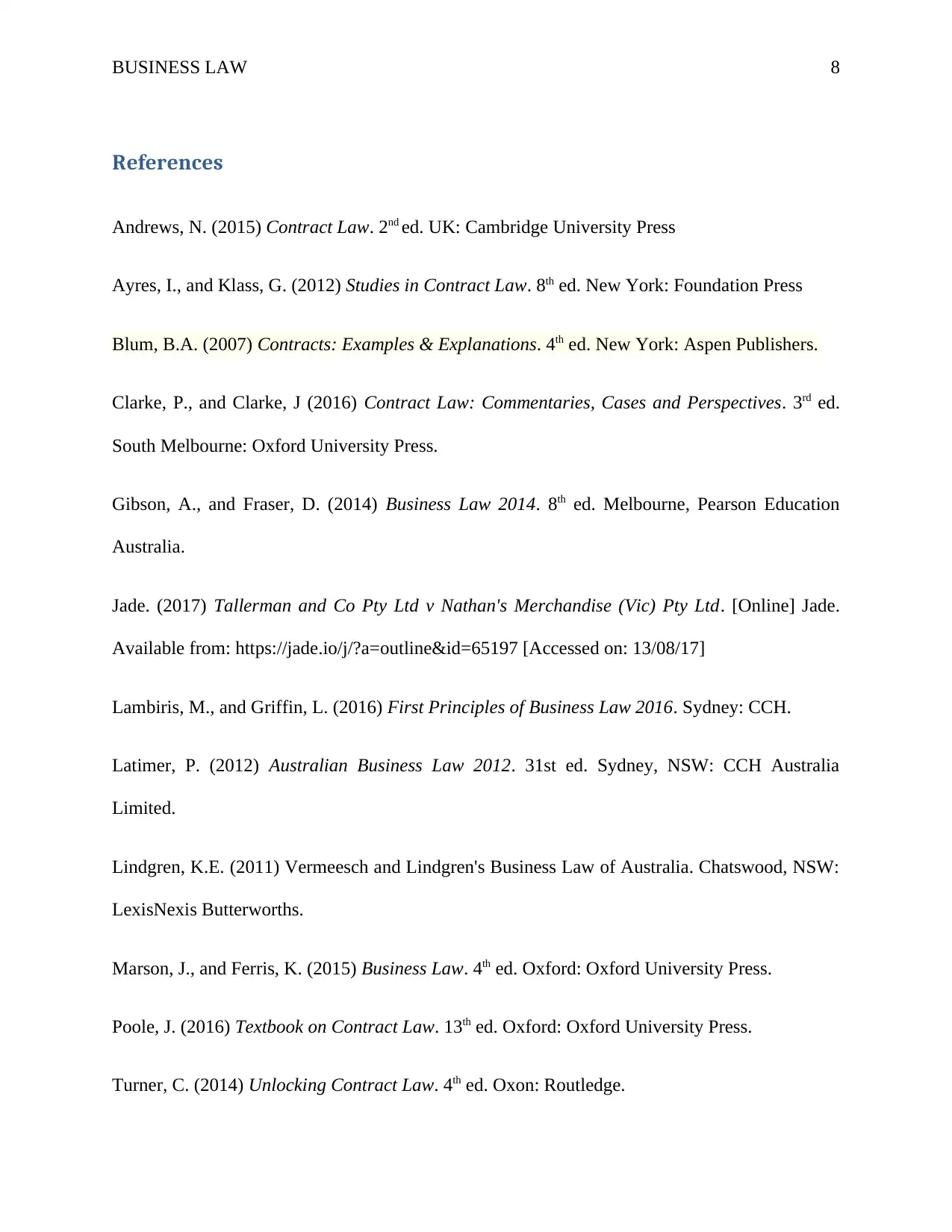
BUSINESS LAW 8
References
Andrews, N. (2015) Contract Law. 2nd ed. UK: Cambridge University Press
Ayres, I., and Klass, G. (2012) Studies in Contract Law. 8th ed. New York: Foundation Press
Blum, B.A. (2007) Contracts: Examples & Explanations. 4th ed. New York: Aspen Publishers.
Clarke, P., and Clarke, J (2016) Contract Law: Commentaries, Cases and Perspectives. 3rd ed.
South Melbourne: Oxford University Press.
Gibson, A., and Fraser, D. (2014) Business Law 2014. 8th ed. Melbourne, Pearson Education
Australia.
Jade. (2017) Tallerman and Co Pty Ltd v Nathan's Merchandise (Vic) Pty Ltd. [Online] Jade.
Available from: https://jade.io/j/?a=outline&id=65197 [Accessed on: 13/08/17]
Lambiris, M., and Griffin, L. (2016) First Principles of Business Law 2016. Sydney: CCH.
Latimer, P. (2012) Australian Business Law 2012. 31st ed. Sydney, NSW: CCH Australia
Limited.
Lindgren, K.E. (2011) Vermeesch and Lindgren's Business Law of Australia. Chatswood, NSW:
LexisNexis Butterworths.
Marson, J., and Ferris, K. (2015) Business Law. 4th ed. Oxford: Oxford University Press.
Poole, J. (2016) Textbook on Contract Law. 13th ed. Oxford: Oxford University Press.
Turner, C. (2014) Unlocking Contract Law. 4th ed. Oxon: Routledge.
References
Andrews, N. (2015) Contract Law. 2nd ed. UK: Cambridge University Press
Ayres, I., and Klass, G. (2012) Studies in Contract Law. 8th ed. New York: Foundation Press
Blum, B.A. (2007) Contracts: Examples & Explanations. 4th ed. New York: Aspen Publishers.
Clarke, P., and Clarke, J (2016) Contract Law: Commentaries, Cases and Perspectives. 3rd ed.
South Melbourne: Oxford University Press.
Gibson, A., and Fraser, D. (2014) Business Law 2014. 8th ed. Melbourne, Pearson Education
Australia.
Jade. (2017) Tallerman and Co Pty Ltd v Nathan's Merchandise (Vic) Pty Ltd. [Online] Jade.
Available from: https://jade.io/j/?a=outline&id=65197 [Accessed on: 13/08/17]
Lambiris, M., and Griffin, L. (2016) First Principles of Business Law 2016. Sydney: CCH.
Latimer, P. (2012) Australian Business Law 2012. 31st ed. Sydney, NSW: CCH Australia
Limited.
Lindgren, K.E. (2011) Vermeesch and Lindgren's Business Law of Australia. Chatswood, NSW:
LexisNexis Butterworths.
Marson, J., and Ferris, K. (2015) Business Law. 4th ed. Oxford: Oxford University Press.
Poole, J. (2016) Textbook on Contract Law. 13th ed. Oxford: Oxford University Press.
Turner, C. (2014) Unlocking Contract Law. 4th ed. Oxon: Routledge.

BUSINESS LAW 9
1 out of 9
Related Documents
Your All-in-One AI-Powered Toolkit for Academic Success.
+13062052269
info@desklib.com
Available 24*7 on WhatsApp / Email
![[object Object]](/_next/static/media/star-bottom.7253800d.svg)
Unlock your academic potential
© 2024 | Zucol Services PVT LTD | All rights reserved.





